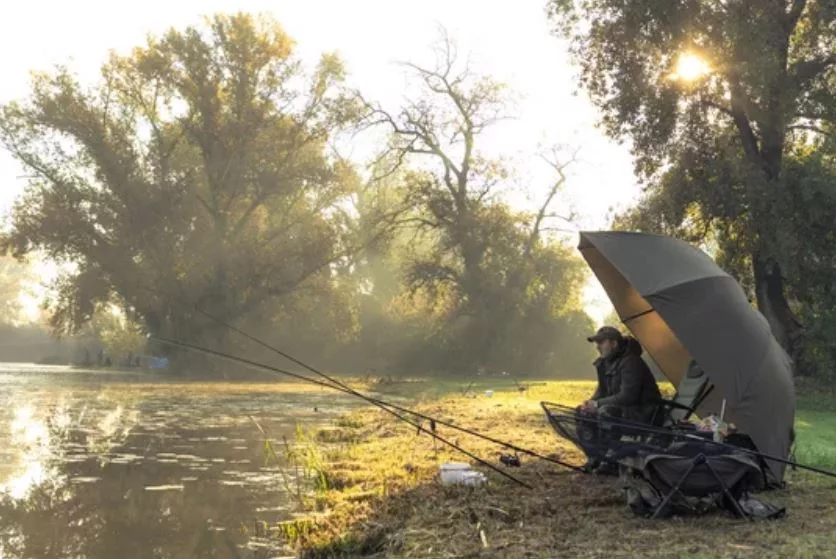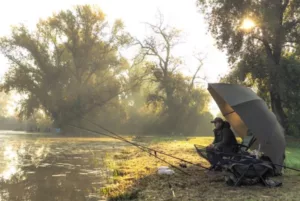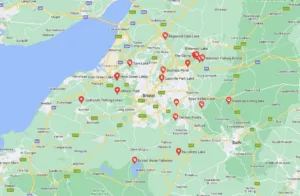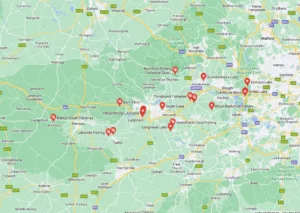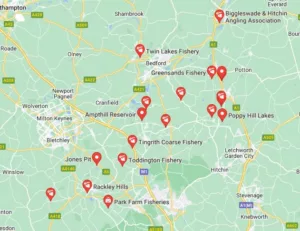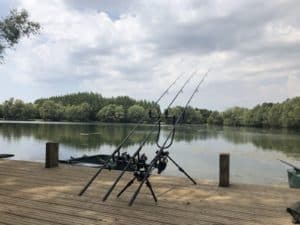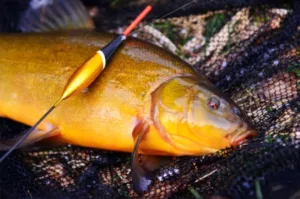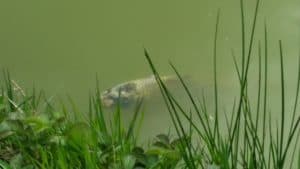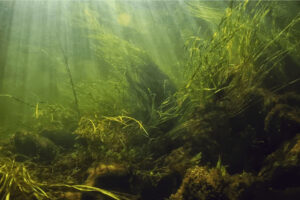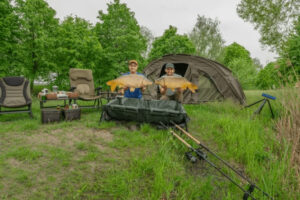Carp fishing in lakes is a popular pastime in the UK, with a large community of dedicated anglers who enjoy the challenge of catching these elusive fish. Lakes provide an ideal habitat for carp, and offer a range of conditions that require different techniques and equipment to master. With a bit of knowledge and practice, anyone can enjoy the thrill of catching carp in lakes.
Understanding the habitat and behavior of carp is crucial for any angler who wants to catch these fish successfully. Carp have distinct preferences for water temperature, depth, and structure, as well as specific feeding habits and times of day when they are most active. By understanding these factors, anglers can choose the right equipment, bait, and rig setup, and present them in a way that mimics the natural feeding habits of carp. This increases the chances of a successful catch and makes for a more rewarding experience on the water.
Understanding Carp in Lakes
The Preferred Habitat of Carp in Lakes
Carp in lakes prefer a habitat that provides a mix of structure and food sources. The following are some key factors to consider when looking for a good spot to fish for carp in a lake:
- Water Depth: Carp can be found in a range of depths in lakes, from shallow margins to deeper water. They tend to move to shallower areas during warmer weather and to deeper areas during colder months.
- Water Temperature: Carp prefer warmer water temperatures, typically between 15°C and 25°C. They are less active and less likely to feed when the water temperature drops below 10°C.
- Underwater Structure: Carp are attracted to underwater structure, such as weed beds, reed beds, lily pads, and snags, where they can find cover and food. They also like to patrol open areas and deeper channels.
- Food Sources: Carp are omnivorous, and will feed on a variety of natural and artificial baits. Some popular carp baits include boilies, pellets, maize, and worms. It’s important to understand the natural food sources available in the lake and to choose baits that mimic them.
By observing the water and the carp behavior, anglers can identify areas that are likely to hold carp and increase their chances of catching them.
How to Locate Carp in Lakes
Locating carp in a lake can be challenging, but there are several methods that can help anglers identify areas where carp are likely to be found:
- Use a Fish Finder: A fish finder is a sonar device that detects fish in the water. It can help anglers locate carp by identifying underwater structure, including weed beds and drop-offs, where carp are likely to feed and rest.
- Observe Carp Behavior: Carp behavior can provide clues as to where they are located in the lake. Look for jumping or rolling carp, which can indicate a feeding area or a group of carp. Also, look for carp bubbles, which are often visible on the surface and can indicate the location of feeding carp.
- Check Wind Direction: Carp tend to move and feed with the wind, so checking the direction of the wind can help anglers identify areas where carp are likely to be located.
- Look for Areas with Natural Food Sources: As mentioned earlier, carp are attracted to areas with food sources such as weed beds and lily pads. Identifying these areas and fishing around them can increase the chances of catching carp.
By using a combination of these methods, anglers can identify areas in the lake where carp are likely to be located and increase their chances of catching them.
The Importance of Understanding the Feeding Habits of Carp
Understanding the feeding habits of carp is crucial when choosing the right bait and rig setup. Carp have different feeding patterns depending on the time of day, water temperature, and available food sources, and using the wrong bait or rig setup can result in poor results or no catch at all. Some carp feeding habits to consider when selecting bait and rig setups include:
- Time of Day: Carp tend to be more active and feed more during the early morning and late afternoon. Fishing during these times can increase the chances of catching carp.
- Water Temperature: Carp are more likely to feed when the water temperature is warmer, typically between 15°C and 25°C. During colder weather, carp may be less active and less likely to feed.
- Food Sources: Carp are omnivorous and will feed on a variety of natural and artificial baits. It’s important to understand the natural food sources available in the lake and to choose baits that mimic them.
- Rig Setup: The right rig setup can also impact the chances of catching carp. Some popular rigs for carp fishing include the hair rig, the bolt rig, and the chod rig. The type of rig setup used will depend on the fishing conditions and the behavior of the carp.
By understanding the feeding habits of carp and selecting the right bait and rig setup, anglers can significantly increase their chances of catching carp in lakes.
Choosing the Right Equipment
The Types of Fishing Rods, Reels, and Lines that Are Suitable for Carp Fishing in Lakes
Selecting the right fishing equipment is an important part of carp fishing in lakes. Here are some types of fishing rods, reels, and lines that are suitable for carp fishing in lakes:
- Fishing Rods: Carp rods are typically longer and more powerful than standard fishing rods. They range in length from 9 to 12 feet and are designed to cast heavy weights and handle large fish. They can be made of various materials such as carbon fiber, fiberglass or a combination of both, depending on the type of fishing and personal preferences.
- Fishing Reels: Carp reels are designed to hold a large amount of line and to provide a smooth and consistent drag system. They come in two main types, either a baitcasting or a spinning reel. Baitcasting reels are best for long-distance casting, while spinning reels are ideal for close-range fishing.
- Fishing Lines: The most popular type of line for carp fishing in lakes is monofilament, which is a single strand nylon line that stretches and absorbs shock well. Fluorocarbon and braided lines are also commonly used. It is important to choose a line with the appropriate breaking strain that matches the weight of the fish being targeted.
Choosing the right fishing equipment will depend on the angler’s experience level, personal preferences, and the type of carp fishing they plan to do. Investing in high-quality equipment can make a significant difference in the angler’s success and enjoyment of the sport.
The Importance of Selecting the Right Hook and Bait
Selecting the right hook and bait is essential for successful carp fishing in lakes. Different hooks and baits will work better in certain conditions, depending on the carp behavior and the underwater environment. Here are some things to consider when selecting the right hook and bait:
- Hook Size: The size of the hook will depend on the size of the bait being used and the size of the fish being targeted. Hooks come in a range of sizes, and it’s important to choose a hook that is appropriate for the bait and the fish.
- Bait Type: Carp are omnivorous and will eat a variety of natural and artificial baits. Popular baits for carp fishing include boilies, pellets, maize, and worms. It is important to match the bait to the conditions and carp behavior in the lake. For example, sweet-flavored baits may be more effective in warmer water, while protein-rich baits may work better in colder water.
- Bait Presentation: The way the bait is presented can also impact the chances of catching carp. It’s important to present the bait in a way that mimics the natural feeding habits of carp. This may include using a hair rig, which allows the bait to move freely, or a rig setup that allows the bait to float.
By selecting the right hook and bait and matching them to the conditions and carp behavior in the lake, anglers can increase their chances of catching carp. It’s important to experiment with different combinations to find the most effective setup for a given situation.
Techniques for Carp Fishing in Lakes
The Different Techniques for Catching Carp
There are several techniques that can be used to catch carp in lakes, and each one requires a different setup and approach. Here are some of the most popular techniques for catching carp:
- Float Fishing: Float fishing is a popular technique that involves using a float to suspend the bait at a specific depth in the water. This technique is particularly effective for catching carp in shallow water or near the surface. It is also a good option for novice anglers as it is easy to set up and use.
- Ledgering: Ledgering, also known as bottom fishing, involves placing the bait on the bottom of the lake using a weight. This technique is particularly effective for catching carp in deeper water or near the bottom. It requires a heavier setup and a more sensitive line to detect bites.
- Stalking: Stalking involves moving around the lake to locate carp and fishing for them using a variety of techniques. This technique requires a mobile setup and is often used when fishing for carp that are feeding close to the bank. Stalking requires stealth and patience to avoid spooking the fish.
Other techniques for catching carp include spodding, which involves using a bait rocket to distribute bait, and surface fishing, which involves using floating bait and imitating the natural feeding habits of carp. Each technique has its advantages and disadvantages, and anglers will need to experiment to find the most effective method for the situation.
How to Present the Bait in A Way that Mimics the Natural Feeding Habits of Carp
Presenting the bait in a way that mimics the natural feeding habits of carp is crucial for a successful catch. Carp are wary fish that are easily spooked, so presenting the bait in a way that looks natural will increase the chances of catching them. Here are some tips for presenting the bait:
- Use the Right Rig: Using the right rig is crucial for presenting the bait in a natural way. The hair rig is a popular rig that allows the bait to move freely, mimicking the natural movement of food in the water. The rig should also be balanced to ensure that the bait sits naturally in the water.
- Use the Right Bait: The bait used should mimic the natural food sources of the carp in the lake. Popular baits for carp fishing include boilies, pellets, maize, and worms. The bait should be chosen based on the feeding habits of the carp and the conditions in the lake.
- Cast in the Right Area: Carp tend to feed in areas with structure, such as weed beds or lily pads. It’s important to cast the bait in these areas to increase the chances of catching carp.
- Use a Slow Presentation: Carp are cautious fish and may take time to approach the bait. A slow and natural presentation will increase the chances of the carp taking the bait. It’s important to be patient and avoid jerky or sudden movements that may spook the fish.
- Match the Hook Size: The size of the hook should match the size of the bait being used. A hook that is too big or too small can make the bait look unnatural and reduce the chances of a successful catch.
By presenting the bait in a way that mimics the natural feeding habits of carp, anglers can increase their chances of catching these elusive fish in lakes. It’s important to experiment with different techniques and baits to find what works best in the specific lake being fished.
Tips for Playing and Landing Carp, Including how To Tire the Fish out And Avoid Common Mistakes
Playing and landing carp can be a challenging and exciting part of carp fishing in lakes. Here are some tips for playing and landing carp:
- Use the Right Equipment: A strong and durable rod and reel setup is important for playing and landing carp. It’s also important to use a suitable line and hook that can handle the weight of the fish.
- Tire the Fish Out: Carp are powerful fish that can put up a strong fight. To tire the fish out, it’s important to keep the line tight and apply pressure when the fish is pulling. Anglers should also avoid reeling the fish in too quickly, as this can cause the fish to panic and use up its energy too quickly.
- Use a Landing Net: Using a landing net can make it easier to land carp, as it provides a safe and secure way to bring the fish to the bank. When using a landing net, it’s important to avoid lifting the fish too high off the water and to handle the fish gently to avoid injuring it.
- Avoid Common Mistakes: Common mistakes when playing and landing carp include using too much force, allowing the line to go slack, and lifting the fish out of the water by the line. To avoid these mistakes, anglers should be patient and use a smooth and steady approach to playing and landing the fish.
- Release the Fish Safely: After landing the carp, it’s important to release the fish safely and quickly. Anglers should wet their hands before handling the fish and avoid keeping the fish out of the water for too long. The fish should be gently released back into the water, facing the current or the wind.
By following these tips, anglers can successfully play and land carp in lakes, while ensuring the safety and well-being of the fish.
Conclusion
Carp fishing in lakes is a popular pastime in the UK, with a large community of dedicated anglers who enjoy the challenge of catching these elusive fish. To catch carp successfully, it is important to understand their habitat and behavior, as well as their feeding habits. Carp in lakes prefer warm water temperatures, specific underwater structures, and a variety of natural and artificial baits. Anglers can use a range of techniques to catch carp, including float fishing, ledgering, and stalking. To increase the chances of catching carp, anglers should present the bait in a way that mimics the natural feeding habits of carp, using the right rig, bait, and cast. Playing and landing carp can be a challenging but rewarding part of carp fishing, and anglers should use the right equipment, tire the fish out, avoid common mistakes, and release the fish safely.
If you are an angler who is passionate about carp fishing, then I encourage you to put the knowledge you have gained from this article into practice. Carp fishing in lakes can be an exciting and challenging pastime, and there is always room for experimentation and improvement. Try out different techniques and baits to find what works best for you in the specific lake you are fishing. Remember to always follow fishing regulations and ethical fishing practices, and to release fish safely and responsibly. By putting your knowledge into practice and experimenting with different techniques and baits, you can increase your chances of a successful catch and enjoy the thrill of carp fishing in lakes.
FAQ’s
What is the best time of day to fish for carp in a lake?
Carp tend to be more active and feed more during the early morning and late afternoon. These are often the best times of day to fish for carp in lakes. During the middle of the day, especially during hot weather, carp may be less active and less likely to feed. However, it’s important to remember that every lake and situation is different, and factors such as weather, water temperature, and food availability can impact the feeding habits of carp. It’s always a good idea to observe the water and carp behavior and adjust the fishing time accordingly.
How deep should I cast my bait when carp fishing in a lake?
The depth at which you should cast your bait when carp fishing in a lake will depend on a variety of factors, including the time of day, the water temperature, and the behavior of the carp. As a general rule, carp tend to feed at different depths depending on the time of day and water temperature. During the early morning and late afternoon, they may be feeding close to the surface or in shallower water, while during midday and in colder water, they may be feeding in deeper water. It’s a good idea to experiment with different depths and observe carp behavior to determine where they are feeding. Using a fish finder can also be helpful in identifying the depth at which carp are located. In general, it’s best to start by fishing at different depths and adjusting the depth based on the feeding habits of the carp.
What types of bait are best for catching carp in a lake?
Carp are omnivorous and will eat a variety of natural and artificial baits. The best types of bait for catching carp in a lake will depend on the feeding habits of the carp in that specific lake. Here are some popular baits for carp fishing:
- Boilies: Boilies are a popular artificial bait made from a mix of ingredients such as fishmeal, maize, and other proteins. They come in a range of flavors and sizes and can be used on hair rigs or as free offerings.
- Pellets: Pellets are another popular artificial bait made from compressed fishmeal or other proteins. They can be soaked in water or flavorings and used as free offerings or on a hair rig.
- Maize: Maize, or sweetcorn, is a popular natural bait for carp fishing. It can be used on a hair rig or as a loose feed.
- Worms: Worms are a natural bait that carp will often feed on. They can be used on a hair rig or as a loose feed.
Other natural baits that can be effective for carp fishing include maggots, casters, and bread. The best approach is to experiment with different baits to find what works best in the specific lake being fished.
What is the best way to present the bait to the carp?
Presenting the bait in a way that mimics the natural feeding habits of carp is crucial for a successful catch. Here are some tips for presenting the bait to the carp:
- Use the Right Rig: The right rig is crucial for presenting the bait in a natural way. The hair rig is a popular rig that allows the bait to move freely, mimicking the natural movement of food in the water. The rig should also be balanced to ensure that the bait sits naturally in the water.
- Cast in the Right Area: Carp tend to feed in areas with structure, such as weed beds or lily pads. It’s important to cast the bait in these areas to increase the chances of catching carp.
- Use a Slow Presentation: Carp are cautious fish and may take time to approach the bait. A slow and natural presentation will increase the chances of the carp taking the bait. It’s important to be patient and avoid jerky or sudden movements that may spook the fish.
- Match the Hook Size: The size of the hook should match the size of the bait being used. A hook that is too big or too small can make the bait look unnatural and reduce the chances of a successful catch.
By presenting the bait in a way that mimics the natural feeding habits of carp, anglers can increase their chances of catching these elusive fish in lakes. It’s important to experiment with different techniques and baits to find the most effective method for the specific lake and the feeding habits of the carp.
Can I use a regular fishing rod and reel for carp fishing in a lake?
Carp fishing can be demanding, and it’s important to use suitable equipment to ensure a successful catch and to minimize the risk of injuring the fish. While it is technically possible to catch carp using a regular fishing rod and reel, it’s not recommended as these setups may not be strong or sensitive enough to handle the weight and power of carp.
Instead, specialized carp fishing equipment is recommended. Carp rods are designed to handle the weight of carp and allow for accurate casting, while carp reels are designed to provide a smooth drag and retrieve. The line used should also be strong and durable, with a high breaking strain.
Using specialized carp fishing equipment will not only increase the chances of a successful catch but also make the fishing experience more enjoyable and rewarding. It’s worth investing in high-quality carp fishing equipment to ensure the best possible outcome.
What should I do if the carp takes off and runs with the line?
If a carp takes off and runs with the line, it’s important to keep the line tight and apply pressure to tire the fish out. Here are some tips for dealing with a carp that is running with the line:
- Keep the Line Tight: It’s important to keep the line tight to avoid giving the fish slack, which can lead to the hook becoming dislodged. Use the drag system on the reel to apply pressure and tire the fish out.
- Apply Pressure: Use the rod to apply pressure to the fish and tire it out. This can be done by lifting the rod and reeling in the line when the fish is not pulling, then lowering the rod and using the drag system when the fish is pulling.
- Avoid Reeling in Too Quickly: Reeling in too quickly can cause the fish to panic and use up its energy too quickly. Use a slow and steady approach to avoid spooking the fish.
- Be Patient: Carp can be powerful and may take some time to tire out. It’s important to be patient and not rush the process, as this can lead to the fish escaping or getting injured.
By following these tips, anglers can successfully play and land carp that are running with the line, while ensuring the safety and well-being of the fish.
Is it better to fish for carp in shallow or deep water in a lake?
Carp can be found in both shallow and deep water in a lake, and the best fishing spot will depend on the specific lake and the feeding habits of the carp. As a general rule, during the early morning and late afternoon, carp tend to feed close to the surface or in shallower water, while during midday and in colder water, they may be feeding in deeper water. Carp tend to prefer areas with structure, such as weed beds or lily pads, which provide them with cover and food sources.
When selecting a fishing spot, it’s a good idea to observe the water and carp behavior to determine where they are feeding. Using a fish finder can also be helpful in identifying the depth at which carp are located. Experimenting with different depths and areas of the lake can help you to find where the carp are feeding and increase your chances of a successful catch.
Ultimately, the best way to find out where the carp are is to ask other anglers, local fishing guides or to do research on the specific lake you are fishing in. Remember that every lake is different, and it’s important to be flexible and adapt to the conditions of the lake and the behavior of the carp.
What are some common mistakes that I should avoid when carp fishing in a lake?
Carp fishing in lakes can be challenging, and there are a number of common mistakes that anglers should avoid in order to increase their chances of a successful catch. Here are some of the most common mistakes to avoid when carp fishing in a lake:
- Using the Wrong Equipment: Using the wrong equipment can make carp fishing difficult and reduce the chances of a successful catch. It’s important to use specialized carp fishing equipment, including a suitable rod, reel, line, and hooks.
- Fishing in the Wrong Spot: Carp tend to feed in areas with structure, such as weed beds or lily pads. It’s important to cast the bait in these areas to increase the chances of catching carp.
- Using Too Much Bait: Using too much bait can be counterproductive and reduce the chances of a successful catch. It’s important to use the right amount of bait and to spread it out to create a natural feeding pattern.
- Not Paying Attention to the Conditions: Conditions such as weather, water temperature, and time of day can impact the feeding habits of carp. It’s important to pay attention to these conditions and adjust the fishing strategy accordingly.
- Being Impatient: Carp can be cautious fish and may take time to approach the bait. It’s important to be patient and avoid jerky or sudden movements that may spook the fish.
By avoiding these common mistakes, anglers can increase their chances of a successful catch and enjoy the thrill of carp fishing in lakes. Remember to always follow fishing regulations and ethical fishing practices, and to release fish safely and responsibly.
Can I use artificial lures or do I need to use live bait?
While live bait is a popular and effective option for carp fishing in lakes, artificial lures can also be successful if used correctly. Many carp anglers use artificial lures, such as boilies, pellets, and pop-ups, as they are a convenient and easy-to-use option. These artificial baits come in a variety of flavors, sizes, and colors, and can be used on hair rigs or as free offerings.
When using artificial lures, it’s important to match the bait to the feeding habits of the carp in the specific lake being fished. Carp tend to be attracted to baits that are high in protein and nutrients, and that mimic their natural food sources. It’s also important to present the bait in a way that mimics the natural feeding habits of carp.
While live bait can be an effective option, artificial lures can also be successful and provide a convenient and easy-to-use alternative. Experimenting with different baits and techniques can help anglers to find the most effective approach for the specific lake and the feeding habits of the carp.
How can I improve my chances of catching a larger carp in a lake?
Catching a larger carp in a lake can be challenging, but there are several things you can do to improve your chances:
- Use Bigger Bait: Larger carp tend to feed on bigger baits, so using larger boilies or other bait can help to attract bigger fish.
- Choose the Right Spot: Larger carp tend to be more cautious and prefer areas with structure, such as weed beds or lily pads. Fishing in these areas can increase the chances of catching a larger fish.
- Use the Right Equipment: It’s important to use suitable equipment, including a strong and durable rod, reel, line, and hooks, to handle the weight and power of larger carp.
- Be Patient: Catching a larger carp can take time, and it’s important to be patient and avoid rushing the process. Wait for the fish to take the bait and play it carefully to avoid injuring the fish.
- Pay Attention to the Conditions: Conditions such as weather, water temperature, and time of day can impact the feeding habits of carp. It’s important to pay attention to these conditions and adjust the fishing strategy accordingly.
By following these tips and being persistent, anglers can increase their chances of catching a larger carp in a lake. Remember to always follow fishing regulations and ethical fishing practices, and to release fish safely and responsibly.
I have made a lot of mistakes during my fishing sessions and don’t want you to make the same mistakes. I’ve learned the hard way over 20 years of fishing most weekends, testing, tweaking, and testing again and now want to help you excel with your carp fishing.
If you need any help, you can reach me at Fishing Again’s Facebook page
Last Updated on February 3, 2024 by Shane

